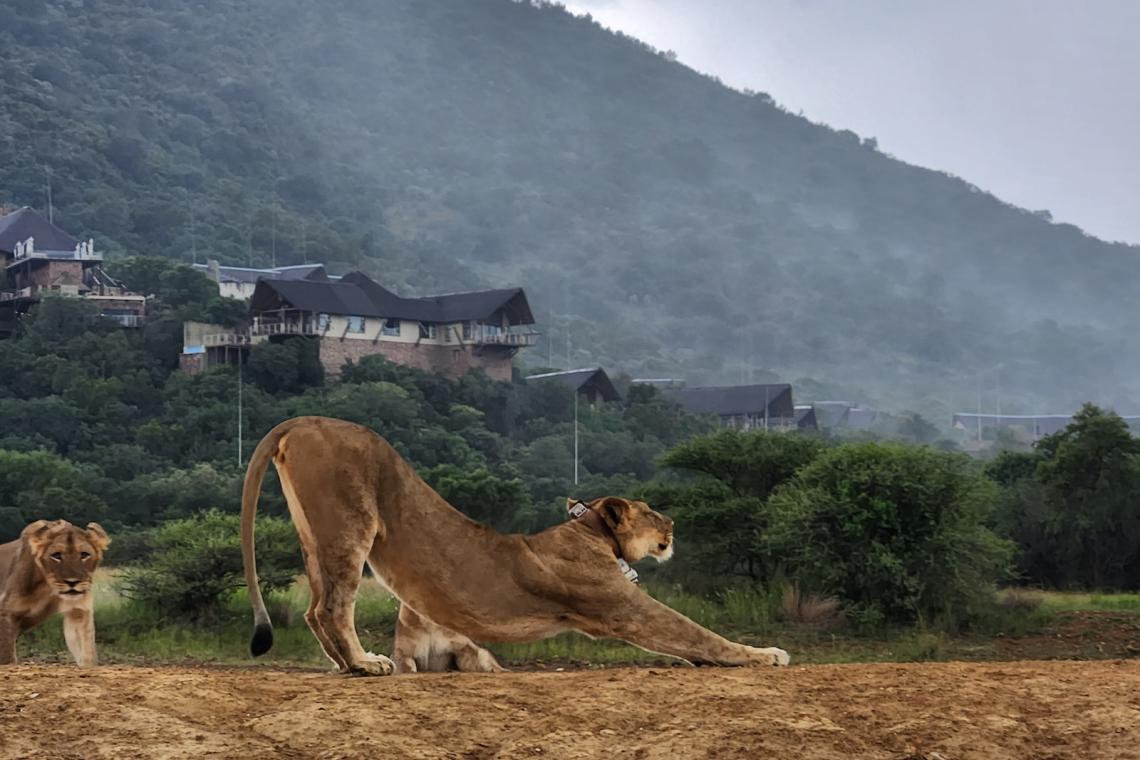Limpopo’s wilderness-rich Waterberg region was on the verge of getting a new residential golf estate and hotel development. Then, suddenly, things changed, and in 2010, the property was sold. What has arisen in its place is a leading conservation effort in the form of the 12,000 ha Qwabi private game reserve, which is home to, amongst others, the Big Five.
Qwabi is named after Felis lybica, the African wildcat, and is located some 67 kilometres northwest of Bela-Bela. More importantly, the reserve is a two-and-a-half-drive from Johannesburg, a significant source of business for Qwabi’s two relatively new lodges.
Main image: The camera collar at Qwabi is the first project of its kind on a big predator in Africa. In the background is Babohi Lodge. (Picture: Ludi Kern)
The 58-room Letamo opened in December 2022 and was followed in May last year by Babohi, with its 25 rooms on a lush hillside some eight kilometres away. Newmark Hotels & Reserves manages hospitality operations.
Everything at Qwabi, however, begins and ends with the ecosystem's health. “The focus of the owner is a sustainable and ecologically sound property,” says reserve manager Bradley Algar. “That has been our drive. Our team's goal is to be a leading example of conservation on a private game reserve in South Africa.”
In pursuing this vision, Qwabi has invested heavily in the game reserve, which has a perimeter of around 60km and a road network of 350km. In addition to re-introducing the Big Five and embarking on a consistent programme of veld rehabilitation, it has appointed experienced conservationists.
To stay at Qwabi's Lodges, book at Booking.com for Letamo and Bahohi,
Renowned translocation specialist Dr Andre Uys is the in-house veterinarian and CEO. The reserve ecologist is Ludi Kern, who has a background in invasive plant species and previously assisted St Helena Island in setting up a management framework to combat their effects on the island. Algar has been in the Waterberg for a decade and has been in Qwabi since 2021.
Cutting-edge technology is bolstering their efforts. One of the Qwabi initiatives is “a South African first” in the use of specialised collars equipped with a GPS tracker, camera, microphone, and accelerometer.
It’s all a far cry from where the property once was, just a few years ago.

Qwabi is home to several critically endangered species, including the rhino and the ground hornbill. (Picture: Ludi Kern)
A Brief History
Qwabi’s current footprint was once a patchwork of farms. Among them was a property whose owner set about developing hospitality infrastructure. Permission was sought to develop an 18-hole golf course, 513 residential stands, ten 20-bed lodges, a hotel with 20 rooms, a clubhouse, an equestrian centre, stables, staff housing, a workshop and a maintenance centre. In 2009, government permission was granted, but a year later, the property was up for sale.
It was snapped up to become the heart of Qwabi Private Game Reserve. Adjoining farms were gradually acquired, and soon, a management plan was in place for removing alien species and old fence lines, implementing veld rehabilitation, and returning the Big Five game to the area.
Large swathes had been used for various agricultural activities such as livestock farming.
It is, however, a sign of the times that eco-tourism is emerging as a dominant activity in the Waterberg, says Algar.
“There is certainly a shift towards conservation from traditional agriculture. Most properties in greater Waterberg are involved in conservation or the maintenance of the natural environment.”
The extent of the change led to large parts of the Waterberg plateau receiving protection in 2001 as a UNESCO Biosphere Reserve.
Significantly, the Qwabi private game reserve is located within an area rated by SANBI of the two most critically biodiverse states or “irreplaceable sites”. They’re designated as CBA (Critical Biodiversity Area) 1 and 2.
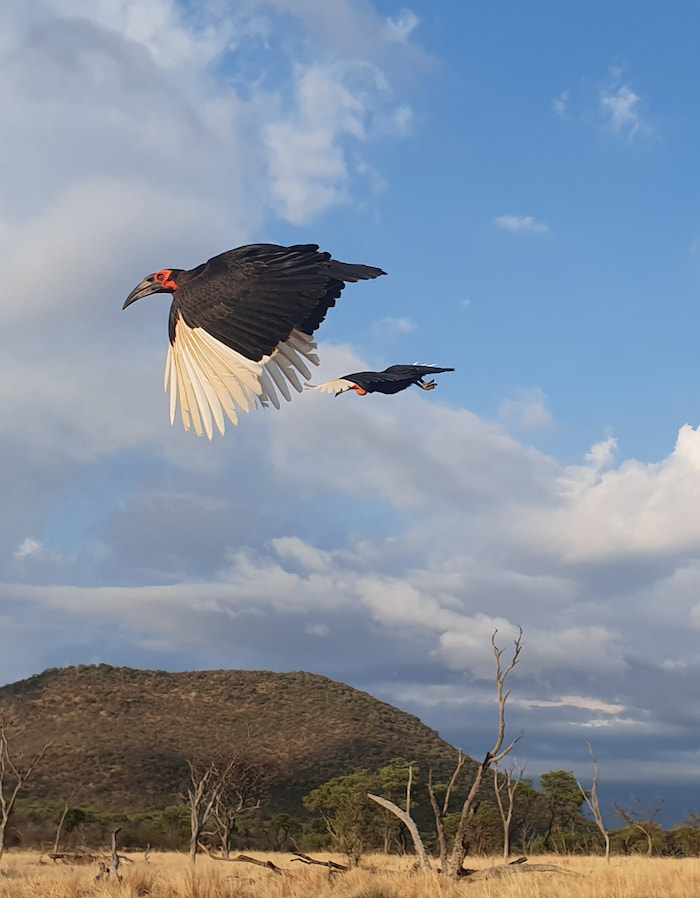
The scarcity of ground hornbills makes them a rare sighting. Seeing them in flight is even less so. (Picture: Ludi Kern)
About the Waterberg
"What is the Waterberg anyway?” writes Richard Wadley in his comprehensive book Echoes of the Waterberg (2019, Protea). “In its broadest modern context, it could be taken to mean the area contained within the District Municipality of that name - an area of almost 45 000km², making it the largest district in Limpopo Province...
"This is the real Waterberg: an upland of magnificent hill ranges, hidden valleys, scenic vistas, virgin wetlands, perennial streams, sparse human population, limited infrastructural, agricultural or commercial development; and a burgeoning diversity and population of wildlife, both faunal and floral....”
Beyond the wilderness areas, however, is ancient human heritage. “The general public's ignorance about the Waterberg plateau is matched by the scant knowledge amongst most of the locally resident community of the region's fascinating and complex history," says Wadley.
By way of some context, the region encompasses the towns of Bela-Bela, Lephalale, Modimolle, Mokopane, Mookgophong, Thabazimbi and Vaalwater.

Black rhinos will soon join Qwabi’s population of white rhinos at the 12,000 ha private game reserve. (Picture: Ludi Kern)
Conservation at Qwabi
Qwabi Private Nature Reserve is home to various species, with elephants, lions, leopards, buffaloes, and white rhinos leading the most obvious path. There are also sables, eland, impala, waterbuck and many more.
According to the current National Vegetation Map (SANBI, 2018), there are three vegetation types at Qwabi: Waterberg Mountain Bushveld, Central Sandy Bushveld, and Western Sandy Bushveld.
Furthermore, Qwabi lies within a savanna biome that has been identified as supporting the highest diversity of bird species within the Southern African sub-region. The Waterberg System Important Bird & Biodiversity Area (IBA) is home to six globally threatened species and seven resident regionally threatened birds.
Qwabi is a member of Rooiberg Bewaria, a PBO and leading rural community association. It is comprised of approximately 70 members, and its constitutional aims are to conserve the fauna and flora of the Waterberg, coordinate responses to fire, and promote and improve the quality of life of the Waterberg community at large.
Bewaria has developed and operationalised the Rooiberg Bewaria Conservation Plan, supported by its more than 30 environmental monitors and emergency centre, which collaborates with rural safety Forums, SAPS, ESU, and SANParks to protect and conserve the area.
Qwabi is also an active member of the Waterberg Landscape Alliance, financially supports the crime detection camera network in the area, and has been part of efforts to ward off mining in the region, too.
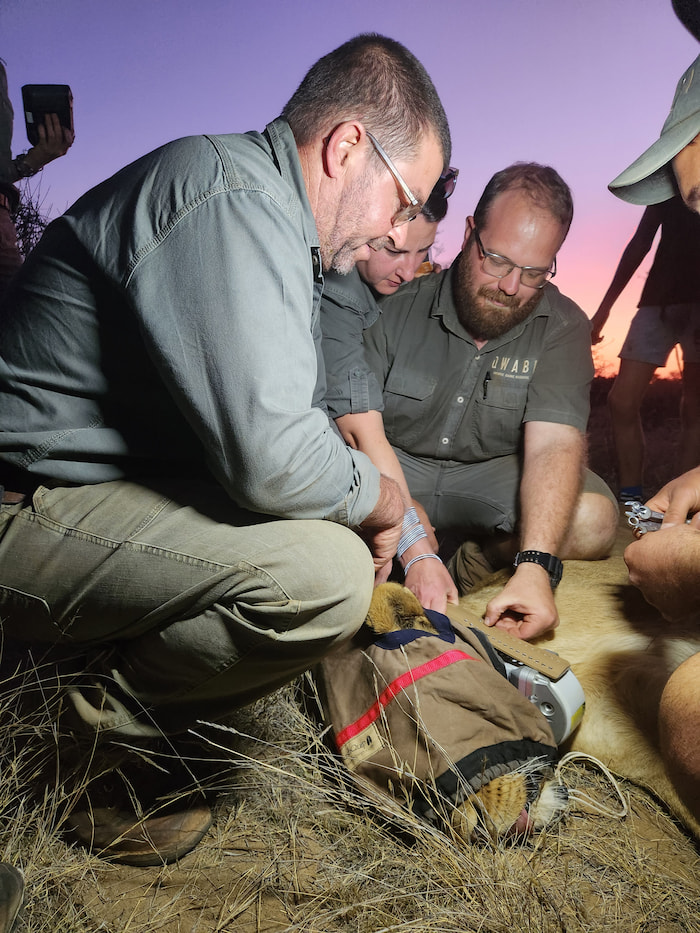
Attaching one of Qwabi’s lion camera collars are, from left: Dr Andre Uys, Ludi Kern and Brad Algar. (Picture: Reilly Mooney)
Genetics
Algar says Qwabi’s management plan covers a broad spectrum, including contributing to overall conservation within the Waterberg. “As a closed system, there’s little automatic gene flow. We therefore work with other properties to share genes and participate in meta-population programmes.”
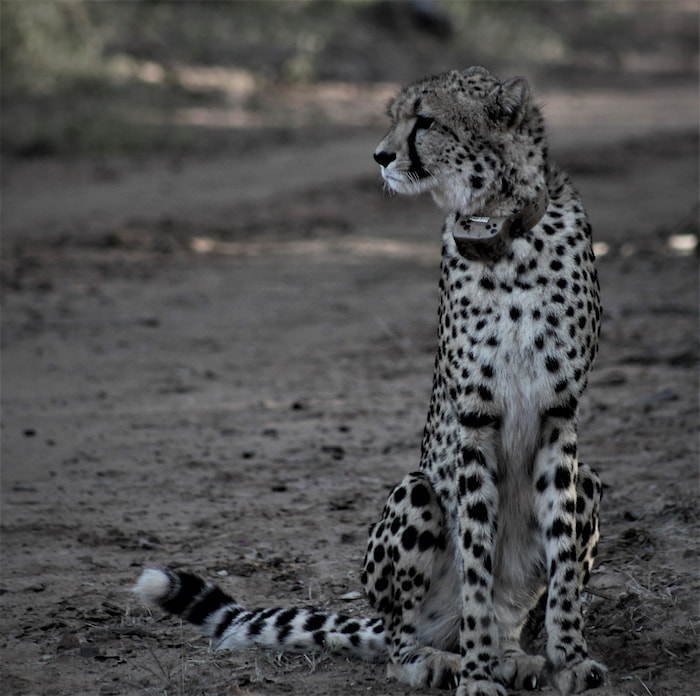
In addition to the lions, selected cheetahs at Qwabi also have collars as part of the reintroduction management plan. (Picture: Ludi Kern)
Habitat
“Historically, there has been a big agricultural element - cattle, citrus and nuts. The property has gone through extensive restoration, and in some instances, we're still dealing with this today,” says Algar.
“Much of the open land was used for farming, negatively impacting the grass cover. As a result, there has been substantial rehabilitation in planting grass, fixing erosion channels created in the past, implementing regular fire regimes, and controlling bush encroachment.
“It's a long-term project and never just a quick in-and-out. If we open up an area, we know that for the next three to five years we're invested into that area for maintenance and follow-up.”
Among the solutions applied at Qwabi is a special Waterberg-specific seed mix supplied by a local manufacturer. “The mix contains only seeds that are naturally occurring in the area. we don't put anything on the property that occurs outside the distribution range,” Algar says.
Added to the complexity of the operation is wildlife considerations too. “When you introduce a species you have to think of their wellbeing not just immediately but for the next 20 or 30 years,” says Kern. “Your plan must include future population management and of course your ecosystems and habitat management too.”
Qwabi has an all-encompassing overarching, five-year management plan. It includes an annual review, which guides the yearly plan of operations. An end-of-year review is also used to add tweaks and changes depending on the goals for the next five years. “On top of that comes the individual species management plan as and when required by LEDET, the government body that controls conservation in Limpopo,” says Algar.

Lion action at Qwabi. (Picture: C Roberts/Canon R10)
Find out more about Canon R10 on Amazon
Hornbills
Neighbourly collaboration is a cornerstone of success for any conservation initiative. “The hornbills are an example,” Kern says about Qwabi, adding that the critically endangered birds are free to roam. “In monitoring their movements, we all share reports and sightings.
“Getting to that point, however, takes a lot of awareness and conversations.”
In addition, information is shared on threats. One of the biggest to hornbills and all secondary feeders is lead poisoning. This typically occurs when scavengers ingest ammunition, and it also leads to secondary poisoning in predators.
“We lobby for the use of lead-free ammunition whenever we have the opportunity,” says Algar. “The cost of this copper ammunition, as opposed to lead, is often negligible depending on where you source it from.”
Qwabi joined the Hornbill award-winning project under Dr Lucy Kemp and ran from nearby Mabula Game Reserve, introducing its first group of birds in 2021. Qwabi is currently preparing its fourth group for release from the property’s temporary aviary.
“Not all the birds brought in have survived, and some of the birds joined other groups,” reports Kern. “The birds are normally brought in threes, one being accustomed to the wild and hopefully guide the other two, which are hand-reared.
“They're in the aviary for four to five weeks to anchor them in the property. Thereafter, we take over the responsibility of feeding during winter while they’re still in the process of learning to fend for themselves.”
She says the team is hopeful about yet more success with the current group. “The female has shown interest in the nest - an artificial nest made for them.”
The Mabula Ground Hornbill project was instrumental with these nests, made to resemble a typical hornbill nest in the wild closely. They employed three-dimensional scans and built the structure to mimic amongst others, temperature, air flow and entrance size.

From golf to game drives – that’s the story of Qwabi. (Picture: C Roberts/Canon R10)
Cheetah
Another tricky re-settlement project at Qwabi has been cheetah. “It’s such an exciting species because they're notoriously difficult to re-settle,” says Kern. “Especially first-time mothers struggle to raise a litter to maturity under these conditions.”
“Fortunately, with the cheetah female we introduced, all three cubs of her first litter are almost nine months old. It’s really exciting for us.”
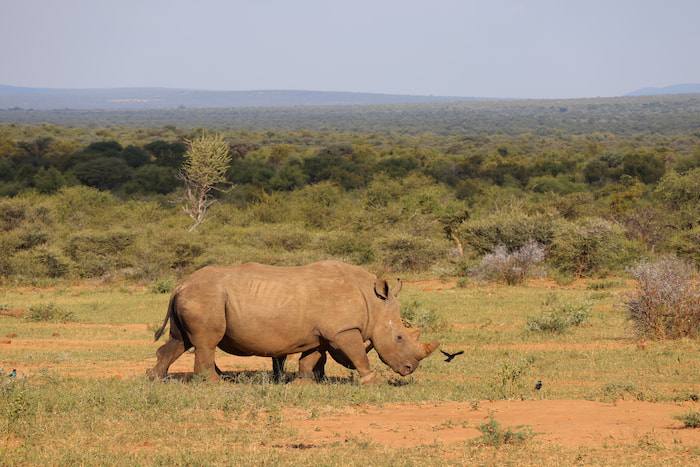
Rhino at Qwabi wears AI-powered bracelets. (Picture: C Roberts/Canon R10)
Find out more about Canon R10 on Amazon
Research
While Qwabi has only been open to the public for 18 months, there has already been some interest from researchers. The hope is for this aspect to grow, especially with the high level of data collection taking place.
“We do yearly vegetation assessments, and these assessments are the baseline for most of the decisions we make - burning, bush encroachment control, and restoration,” says Kern. “Without plant life and a healthy ecosystem, you simply can’t be sustainable.
“Based on our vegetation monitoring, we can assess what our wildlife numbers should be. This changes all the time. You have to assess once or twice a year and include climate considerations. That data is available through our systems, while we also track our animals. These patterns are overlaid on those vegetation maps, giving us a highly refined picture of the situation.
“For researchers, there's so much data and opportunity available.”
Algar says the region has numerous exciting projects that has included visits to Qwabi by researchers from Pretoria University studying bats and doing camera trap surveys.
“The lion collars themselves are part of a longer-term study, and ultimately, it will give us an even clearer understanding of our reserve - even more than what we know now.”
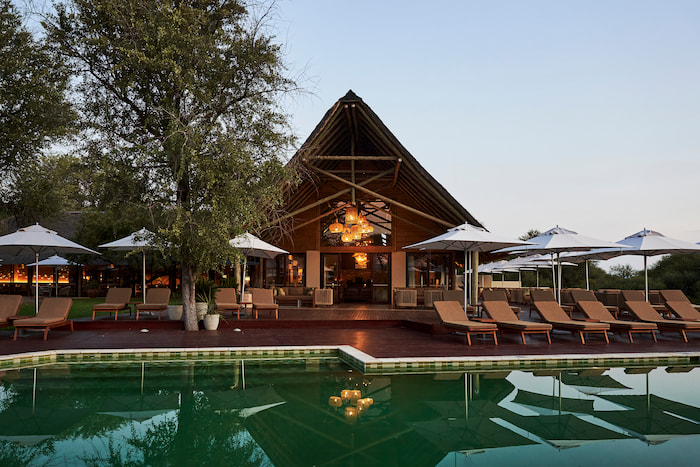
Letamo Lodge promotes family safaris and has a variety of facilities, including a spa, padel court and kid’s club. (Picture: Newmark Hotels & Reserves)
Lions
“The lion camera is the first project of its kind on a big predator in Africa,” explains Kern. “In collaboration Dr Tracey Kreplins of the Department of Primary Industries and Regional Development in Australia) and Dr Haemish Melville of the Applied Behavioural Ecology and Ecosystems Research Unit at UNISA, we’ve fitted camera collars to four of our adult females.”
She explains that the primary goal is to evaluate the utility of satellite collars with integrated video cameras to investigate the behaviour of free-roaming lions. “We hope to learn more about their activity, prey selection, hunting activity and interaction between individuals and other predators.”
“It's not a live feed, and the collars will eventually have to come off after 12 months. But putting collars on selected lions has always been part of the reintroduction management plan to prevent break-outs.
“Information retrieved from the mic will provide insight into vocalisations and interactions. The accelerometer triggers the camera, contributing to our current knowledge.”
It’s biggest advantage, says Kern, is that it removes the human element that’s involved in typical observational studies.
Integrated technology
The technology employed provides data usable in numerous applications, including in, for example, anti-poaching.
“Our various systems are able to report and provide analytics as well as surveillance,” says Algar.
“Our rhinos wear AI collars that share location, status and activity data with our teams. The collars suggest movements linked to situations, like difference between giving birth and a poaching incident. They can be tweaked to improve accuracy, as situations present themselves.”
Qwabi makes use of an internal long-range radio network that links reporting devices across the 12 000ha. At the same time, the network allows for the operation of devices such as pumps and fencing.
Poaching
Like most, Qwabi private game reserve too has an APU unit. Information about their activities is kept a closely guarded secret, but visitors do occasionally encounter the armed members out on patrol.
Poaching activity across the region flares up and cools based on prevention strategies. “All reserves are a potential target,” Algar says. “When one area clamps down, pressure shifts to other regions. We're not excluded from this, and the area has seen its fair share of poaching over the years.
“We talk to all properties across the country so we can share intelligence and fight the fight together.”
Human history on the site
From the perspective of human history at Qwabi, Kern says very little is known about the reserve and area. “It certainly needs more investigation.”
A retro-active cultural heritage impact assessment produced in 2023, notes seven cultural sites recorded during a survey, of which four are graveyards and an individual grave and two are historical structures and one Iron Age livestock enclosure.
“We try to preserve the sites as far as we can, but some don't have gravestones,” Algar says. “We have no records about them and exclude those areas from any works we may need to do there.”
The Future
The conservation plans for the future include the addition of spotted hyena and black rhino. “That’s possibly where we’ll stop, based on the species that once naturally occurred in this area,” says Algar.
In terms of infrastructure, it’s likely that the road network will be expanded with the inclusion of some of the old farm jeep tracks that are currently out of bounds.
The opening of a third lodge – Semela - is on the cards too. The main buildings were in place prior to the property’s acquisition and have subsequently been upgraded.
To stay at Qwabi's Lodges, book at Booking.com for Letamo and Bahohi,

